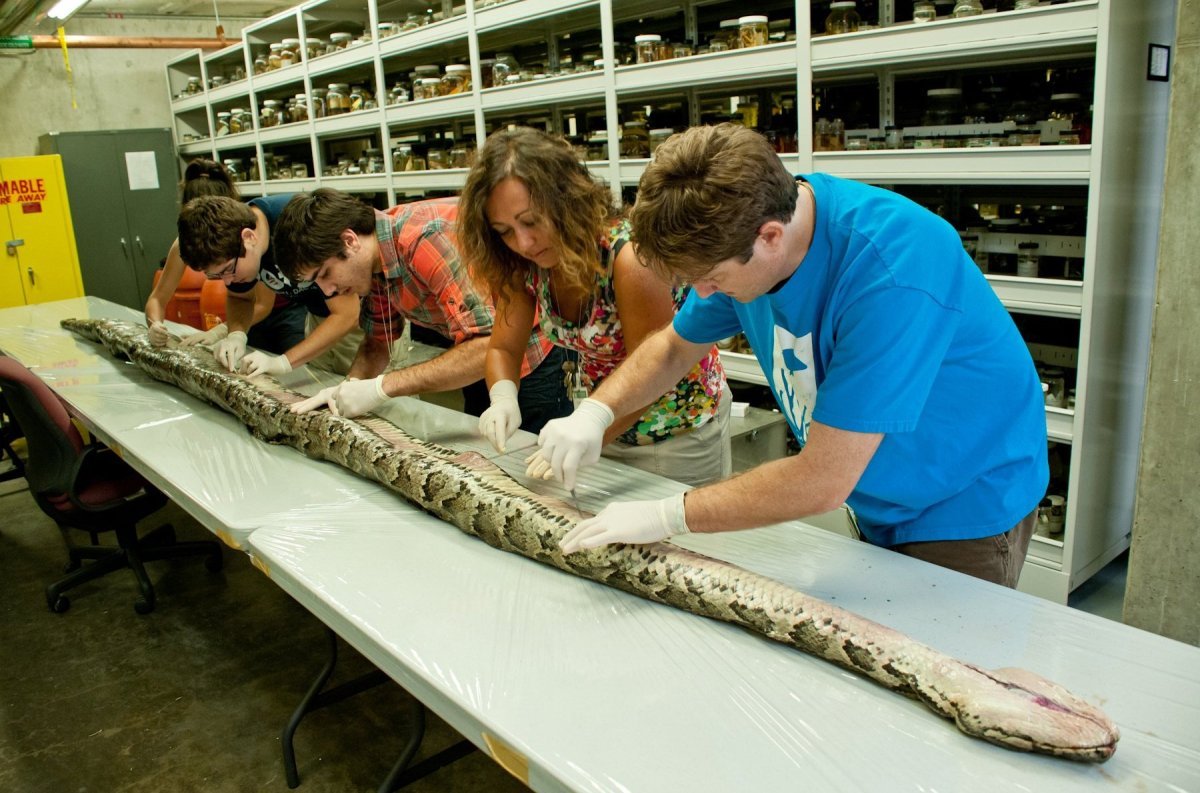There are some Florida records no one wants to see broken, but apparently the exotic snakes invading the Everglades weren't informed.

Researchers with the U.S. Geological Survey captured a state record-breaking Burmese python that was not only a whopping 17 feet and 7 inches long, but carrying an also-record-breaking 87 eggs.
The massive gal weighed 164 pounds, according to staff at the University of Florida, who said the previous records for length and fertility were a measly 16.8 feet and 85 eggs.
"She was a beast!" USGS research ecologist Dr. Kristen Hart, whose team caught the snake, told HuffPost. "She was really impressive."
The massive python was nearly a foot wide, said the Florida Museum of Natural History's herpetology collection manager Dr. Kenneth Krysko (hear him describe her in the video in the slideshow below). The python was sent to the Gainesville museum so UF staff could perform a necropsy for research before mounting the body, which will eventually be returned to Everglades National Park. And then, presumably, there's a party to be had.
"When you find something outside the known or expected range," said FMNH's Ichthyology collection manager Rob Robins, "it's exciting."
Hart said the huge python was initially spotted in March when a "judas snake" -- a male python outfitted with a transmitter for tracking during mating season -- led USGS biologists Thomas Selby and Brian Smith straight to her. Getting the snake from the brush to the office was no small feat, though the very fit Selby and Smith are roughly 6' 5" and 5' 10", respectively.
"She was tired from pulling against them, they were tired from wrestling her," Hart said. "They were just exhausted but also excited: 'You're not gonna believe how big this snake is!'"
The pythons have become such a problem in the Everglades that the plus-sized slitherer wasn't immediately euthanized, but instead put to work as an informant. The USGS team inserted two radio tags and a GPS inside her during surgery, along with a small motion detector about the size of six stacked quarters. The fancy accelerometer records fine-scale activity data four times per second, assembling a wealth of information that would tell researchers at every moment whether the python was right-side up, rolling, killing, or coiling.
For 38 days, the snake was at large in the Everglades again while Hart and other researchers kept careful track of her and their expensive equipment. But the python had to be put down before the gadgets' batteries ran out, surveillance budgets ran over, or the big girl (gulp) reproduced. A female Burmese is capable of laying 50-100 eggs at once, a huge problem when pythons are making exponential and unwelcome gains in one of the world's most fragile ecosystems.
No one knows for sure how imported pythons first made their way into the Everglades, South Florida's long-suffering and slow-moving economic engine. Popular yet unproven theories involve a reptile house destroyed in Hurricane Andrew, sending serpents slithering into the wild, or lazy exotic pet owners who dumped their former charges near Everglades National Park.
Though there hasn't been an attack on a human, the headlines have been sensational: not only has at least one python-vs-alligator battle left both combatants dead, but anentire deer was recently found inside the stomach of a 16-foot snake. Bomb-sniffing dogs have even been employed in an attempt to root out the scaled invaders.
Most alarming are the decimating changes in the delicate Everglades that have accompanied the explosion in invasive snake populations. Biologists and researchers including those at USGS and UF are working to not only limit the snakes' takeover but determine whether or not the pythons are responsible for the near-total disappearance of native mammals including raccoons, opossums, and bobcats.



Researchers with the U.S. Geological Survey captured a state record-breaking Burmese python that was not only a whopping 17 feet and 7 inches long, but carrying an also-record-breaking 87 eggs.
The massive gal weighed 164 pounds, according to staff at the University of Florida, who said the previous records for length and fertility were a measly 16.8 feet and 85 eggs.
"She was a beast!" USGS research ecologist Dr. Kristen Hart, whose team caught the snake, told HuffPost. "She was really impressive."
The massive python was nearly a foot wide, said the Florida Museum of Natural History's herpetology collection manager Dr. Kenneth Krysko (hear him describe her in the video in the slideshow below). The python was sent to the Gainesville museum so UF staff could perform a necropsy for research before mounting the body, which will eventually be returned to Everglades National Park. And then, presumably, there's a party to be had.
"When you find something outside the known or expected range," said FMNH's Ichthyology collection manager Rob Robins, "it's exciting."
Hart said the huge python was initially spotted in March when a "judas snake" -- a male python outfitted with a transmitter for tracking during mating season -- led USGS biologists Thomas Selby and Brian Smith straight to her. Getting the snake from the brush to the office was no small feat, though the very fit Selby and Smith are roughly 6' 5" and 5' 10", respectively.
"She was tired from pulling against them, they were tired from wrestling her," Hart said. "They were just exhausted but also excited: 'You're not gonna believe how big this snake is!'"
The pythons have become such a problem in the Everglades that the plus-sized slitherer wasn't immediately euthanized, but instead put to work as an informant. The USGS team inserted two radio tags and a GPS inside her during surgery, along with a small motion detector about the size of six stacked quarters. The fancy accelerometer records fine-scale activity data four times per second, assembling a wealth of information that would tell researchers at every moment whether the python was right-side up, rolling, killing, or coiling.
For 38 days, the snake was at large in the Everglades again while Hart and other researchers kept careful track of her and their expensive equipment. But the python had to be put down before the gadgets' batteries ran out, surveillance budgets ran over, or the big girl (gulp) reproduced. A female Burmese is capable of laying 50-100 eggs at once, a huge problem when pythons are making exponential and unwelcome gains in one of the world's most fragile ecosystems.
No one knows for sure how imported pythons first made their way into the Everglades, South Florida's long-suffering and slow-moving economic engine. Popular yet unproven theories involve a reptile house destroyed in Hurricane Andrew, sending serpents slithering into the wild, or lazy exotic pet owners who dumped their former charges near Everglades National Park.
Though there hasn't been an attack on a human, the headlines have been sensational: not only has at least one python-vs-alligator battle left both combatants dead, but anentire deer was recently found inside the stomach of a 16-foot snake. Bomb-sniffing dogs have even been employed in an attempt to root out the scaled invaders.
Most alarming are the decimating changes in the delicate Everglades that have accompanied the explosion in invasive snake populations. Biologists and researchers including those at USGS and UF are working to not only limit the snakes' takeover but determine whether or not the pythons are responsible for the near-total disappearance of native mammals including raccoons, opossums, and bobcats.



No comments:
Post a Comment